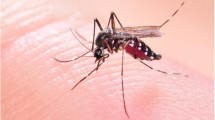Abstract
In order to evaluate the effect of permethrin-treated wall cloth against phlebotomine sandflies, a study lasting 26 months (February 1989 to March 1991) was conducted in Marigat Location of Baringo District, Kenya, an endemic focus of both visceral and cutaneous leishmaniases. In six experimental villages, a total of 2000 houses were fitted with cloth made of cotton and impregnated with permethrin EC 20% at a dosage of 0.5 g/m2 diluted in water. Houses in the two control villages were not fitted with cloths and were located 1.5 km away from the experimental area. Traps made of clear polythene sheeting were coated with castor oil and placed inside houses to collect endophilic sandflies. In the experimental villages, the permethrin-treated wall cloth (called Mbu cloth) reduced the population of sandflies found inside houses by 52-73%. Phlebotomus martini and P. duboscqi, vectors of visceral and cutaneous leishmaniases, were reduced by 76 and 85% respectively. In the experimental villages, highly significant differences were observed between the average numbers of sandflies collected before deployment of the treated wall cloth and those observed after the third treatment of the cloth. No major sandfly reduction was observed however, in the control villages. There was also evidence of feeding reduction due to the permethrin.
Résumé
Afin d’étudier les effets d’écran traité à la permethrine sur les phlébotomes, une étude a été effectuée pendant 26 mois (Février 1989 à Mars 1991) dans un foyer endemic de leishmaniose viscérale et cutanée dans la localité de Marigat, District de Baringo au Kenya. Dans six villages experimentaux, des écrans impregnés à raison d’une dose de 0,5 g/cm2 de permethrine 20% EC, diluée dans l’eau ont été fixés à l’intérieur de 2000 maisons. Les deux villages témoins, situés à 1,5 km des zones traitées, n’ont pas reçu d’écrans. Les pièges “collants” ont été placés dans des maisons pour attraper les phlébotomes endophiles. Dans les villages experimentaux, les écrans traités à la permethrine, appelés “Mbu cloth” ont réduit la population des phlébotomes endophiles dans l’ordre de 52-73%. Phlebotomus martini et P. duboscqi, vecteurs des leishmanioses viscerale et cutanée respectivement, ont été reduits dans l’ordre de 76 et 85%. Dans des villages experimentaux, des differences hautement significatives ont été observées entre les moyennes des phlébotomes attrapés avant le déploiement d’écrans et ceux collectés après traitement. Cependant, il n’y avait pas de réduction majeure des phlébotomes dans les villages témoins. Aussi, il était évident que la réduction du taux d’alimentation des phlébotomes était due aux effets du permethrine.
Similar content being viewed by others
References
Abonnenc E. and Minter D. M. (1965) Bilingual keys for the identification of the sandflies of the Ethiopian Region (French and English). Cah. ORSTOM (Entomol. med.) 5, 1–63.
Abonnenc E. (1972) Les Phlébotomes de la Région Ethiopienne (Diptera: Psychodidae). Mémoires Off. Rech. Sc. Tech. Outre-Mer, No. 55, Paris.
Curtis C. F., Lines J. D., Carnevale P., Robert V., Boudin C, Halna J. M., Pazart L., Gazin P., Richard A., Mouchet J., Charlwood J. D., Graves P. M., Hossain M. L, Kurihara T., Ichimori K., Zuzi L., Baolin L., Majori G., Sabatinelli G., Coluzzi M., Njunwa K. J., Wilkes T. J., Snow R. J. and Lindsay S. W. (1990) Impregnated bednets and curtains against malaria mosquitoes. In Appropriate Technology in Vector Control (Edited by Curtis C. F.), pp. 233. CRC Press, Boca Raton, Florida.
Lines J. D., Curtis C. F., Myamba J. and Njau R. (1985) Tests of repellent of insecticide curtains, bed nets and anklets against malaria vectors in Tanzania. WHO mimeographed document. WHO/VBC 85.920.
Majori G., Sabatinelli G. and Coluzzi M. (1987) Efficacy of permethrin-impregnated curtains for malaria vector control. Med. Vet. Entomol. 1, 185–192.
Majori G., Maroli M., Sabatinelli G. and Fausto A. M. (1989) Efficacy of permethrin-impregnated curtains against endophilic phlebotomine sandflies in Burkina Faso. Med. Vet. Entomol. 3, 441–444.
Maroli M. and Lane R. P. (1987) The effect of permethrin-impregnated nets on Phlebotomus (Diptera: Psychodidae) in central Italy. In Proceedings of NATO-ASI Conference on Leishmaniasis, Zakintos (Greece), 20–27 September 1987.
Mutinga M. J. (1981) An efficient trap for sandflies (Diptera: Psychodidae). Insect Sci. Applic. 1, 203–206.
Mutinga M. J. (1986a) Leishmaniases. Insect Sci. Applic. 7, 421–427.
Mutinga M. J. (1986b) Epidemiology of leishmaniasis in Kenya. Advances in research on vectors and animal reservoirs, and possible control measures. Insect Sci. Applic. 7, 199–206.
Mutinga M. J., Mutero C. M., Basimike M. and Ngindu A. M. (1992) The use of permethrin-impregnated wall cloth (Mbu cloth) for control of vectors of malaria and leishmaniases in Kenya — I. Effect on mosquito populations. Insect Sci. Applic. 13, 151–161.
SAS Institute (1985) SAS User’s Guide: Statistics. SAS Institute, Cary, NC.
SAS Institute (1987) SAS/STAT. Guide for Personal Computers. SAS Institute, Cary.NC.
Schreck C. E., Kline D. L., Chaniotis B. N., Wilkinson N., Mcgovern T. P. and Weidhaas D. E. (1982) Evaluation of personal protection methods against phlebotomine sandflies including vectors of leishmaniasis in Panama. Am. J. Trop. Med. Hyg. 31, 1046–1053.
Schreck C. E., Haile D. G. and Kline D. L. (1984) The effectiveness of permethrin and deet, alone or in combination, for protection against Aedes taeniorhynchus. Am. J. Trop. Med. Hyg. 33, 725–730.
Schreck C. E. and Self L. S. (1985) Bednets that kill mosquitos. World Health Forum, 6, 342–344.
WHO (1984) The leishmaniases. Report of a WHO Expert Committee. WHO Technical Report Series, No. 701.
WHO (1990) Tropical diseases in Media spotlight. In TDR News, UNDP/World Bank/ WHO Special Programme for Research and Training in Tropical Diseases. No. 31.
Author information
Authors and Affiliations
Rights and permissions
About this article
Cite this article
Mutinga, M.J., Basimike, M., Mutero, C.M. et al. The Use of Permethrin-Impregnated Wall Cloth (Mbu Cloth) for Control of Vectors of Malaria and Leishmaniases in Kenya — II. Effect on Phlebotomine Sandfly Populations. Int J Trop Insect Sci 13, 163–172 (1992). https://doi.org/10.1017/S1742758400014302
Received:
Published:
Issue Date:
DOI: https://doi.org/10.1017/S1742758400014302




